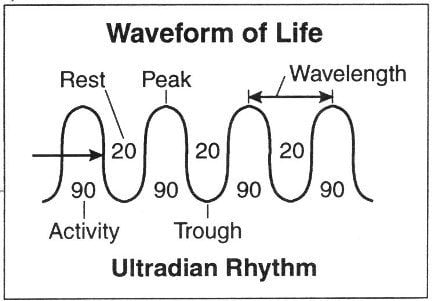The Origin of the 8-Hour Work Day and Why We Should Rethink It
One of the most unchanged elements of our life today is our optimal work time or how long we should work – generally, every person I’ve spoken to quotes me something close to 8 hours a day.
And data seems to confirm that: The average American works 8.8 hours every day. At least, those are the official statistics from the Bureau of Labor Statistics:

And yet, for most of us it is obvious that knowing how long the average person works every day has little to do with how efficient or productive that pattern is. At least, that is what I personally found for my own productivity. So what’s the the right hourly rate?
With success stories from people working 4 hours a week, to 16 hours a day, it’s hard to know if there is an optimal amount. So instead of going with my gut, which often fails me, I thought of looking into actual research on work time and how to optimize it for your happiness and success.
Why do we have 8 hour work days in the first place?
Let’s start out with what we have right now. The typical work day is around 8 hours. But how did we come up with that? The answer is hidden in the tidings of the Industrial revolution.
In the late 18th century, when companies started to maximize the output of their factories, getting to running them 24/7 was key. Now of course, to make things more efficient, people had to work more. In fact, 10-16 hour days were the norm.
These incredibly long work days weren’t sustainable and soon a brave man called Robert Owen started a campaign to have people work no more than 8 hours per day. His slogan was “Eight hours labour, eight hours recreation, eight hours rest.”
It wasn’t until much later that Ford actually implemented the 8 hour work day and changed the standards:
“One of the first businesses to implement this was the Ford Motor Company, in 1914, which not only cut the standard work day to eight hours, but also doubled their worker’s pay in the process. To the shock of many industries, this resulted in Ford’s productivity off of these same workers, but with fewer hours, actually increasing significantly and Ford’s profit margins doubled within two years. This encouraged other companies to adopt the shorter, eight hour work day as a standard for their employees.”
So there we have it. The reason we work 8 hours a day, isn’t scientific or much thought out. It’s purely the a century old norm for running factories most efficiently.
Manage energy not time: How long we work isn’t important & the Ultradian Rhythm
Without wanting to fall into the same trap, it’s time to ask a better question. How many hours we work every day is barely important any more in today’s creative economy.
Instead, the right focus is your energy, according to famous author Tony Schwartz:
“Manage your energy, not your time.”
Schwartz explains that as humans we have 4 different types of energies to manage every day:
- Your physical energy – how healthy are you? (We’ve written about that part before)
- Your emotional energy – how happy are you?
- Your mental energy – how well can you focus on something?
- Your spiritual energy – why are you doing all of this? What is your purpose?
One of the things most of us easily forget is that as humans, we are distinctly different from machines. At the core, this means that machines move linearly and humans move cyclically.
For an efficient work day, that truly respects our human nature, the first thing to focus on are ultradian cycles.
The basic understanding is that our human minds can focus on any given task for 90-120 minutes. Afterwards, a 20-30 minute break is required for us to get the renewal to achieve high performance for our next task again. Here is a better representation of the ultradian rhythm:

So instead of thinking about “What can I get done in an 8 hour day”, I’ve started to change my thinking to “What can I get done in a 90 min session”.
Now that we know we got to split everything in 90 min chunks, it’s time to break down those 90 minutes sessions further.
The core of a productive work day: Focus
The one most crucial to understanding our workflows is how well we can focus. In a stunning research project Justin Gardner found that to actually focus on something our brain uses a 2-step process:
1.) “Sensitivity enhancement”: It means you see a scene or setup and take all the information in that is presented. Then you focus in on what needs your attention. Kind of like “a blurry photo that slowly starts to come into focus”, describes Lifehacker.
2.) “Efficient selection”: This is now the actual zooming in on a task happens. This allows us to enter into what Mihály Csíkszentmihályi calls “Flow” state. Now our actual work on a task happens.
In figure A, as our brain is presented with only 1 task, we are able to separate out distractors (blue) from what’s actually important (yellow).
In figure B, as we are presented with multiple tasks at once, our brain is increasingly easy to distract and combines the actual tasks with distractors.
The key conclusion that Gardner suggests from his study is that we have to both:
- Stop multitasking to avoid being distracted in our work environment.
- Eliminate distractors even when only 1 task is present
Sounds fairly obvious right? And yet, getting it actually done every day is much easier said then done. The good news is that after all, we can even actually change our brain structure from learning to focus. Here are some hands on tips:
The top 4 tips for improving your work day
For my daily workflow at Buffer, I’ve started to make 4 distinct changes to implement the above research better. Here is what worked the best:
- Manually increase the relevance of a task: Now, a lot of us still might struggle to find the focus, especially if no one set a deadline to it. Overriding your attention system, and adding your own deadline together with a reward has shown some of the most significant improvements for task completion according to researcher Keisuke Fukuda.
- Split your day into 90 min windows: Here is something I’ve started to do. Instead of looking at a 8, 6 or 10 hour work day, split it down and say you’ve got 4, 5 or however many 90 minute windows. That way you will be able to have 4 tasks that you can get done every day much more easily.
- Plan your rest so you actually rest: “The fittest person is not the one who runs the fastest, but the one who has optimized their rest time.” Says Tony Schwartz. A lot of the time, we are so busy planning our work day, that we forget about “how” to rest. Plan beforehand what you will do your rest. Here are some ideas: Nap, read, meditate, get a snack.
- Zero notifications: One of the best ideas I’ve ever had was to follow Joel’s advice on Zero Notifications. Having absolutely no counter on my phone or computer changing from 0 to 1 and always breaking my focus has been a huge help. If you haven’t tried this yet, try to turn off every digital element that could become an alert.
Personally, my life has been pretty much turned upside down after implementing these findings over the past few weeks. And I couldn’t be happier. I get both more done and feel happier at the same time.
Oh and as a follow-up post to this one, you might also enjoy “The science of how temperature and lighting impacts our productivity” as well as “The 4 elements of physical energy and how to master them”
Over to you now, what do you think is the best structure of work days? I’d love your insights on this topic.
Image source: Jay Mantri
Try Buffer for free
180,000+ creators, small businesses, and marketers use Buffer to grow their audiences every month.
Related Articles

Learn why social media monitoring matters — and pick one of the seven tools from this list to never miss a brand mention again.

We've rounded up 26 free Instagram tools for creators, marketers, and small businesses

With the newsletters on this list, you'll be able to stay on top of all developments in social media and learn from amazing experts